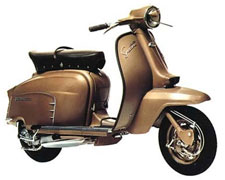Lambretta Model 150 Li Special and SX


150 LiS SpecificationsYears: 1963 - 1966 (Li 150 Special)Amount produced: 69,529 Engine: 1 cylinder, air cooled 2-stroke Induction: piston ported Bore: 57 mm Stroke: 58 mm Cubic capacity: 148 cc Compression ratio: 7.5:1 BHP at rpm: 8.25 @ 5300 Transmission: 4 speed constant mesh Lubrication: 2% Carburetor: Dellorto SH/18 Ignition: contact breaker & points Ignition timing: 23 degrees BTDC Breaker gap: 0.35-0.45 mm Voltage: 6 volt Wheel size: 10" Tire size: 3.5 x 10 Max speed: 53 mph Total dry weight: 231 lbs |
150 SX SpecificationsYears: 1966 - 1969 (SX 150)Amount produced: 31,238 Engine: 1 cylinder, air cooled 2-stroke Induction: piston ported Bore: 57 mm Stroke: 58 mm Cubic capacity: 148 cc Compression ratio: 7:1 BHP at rpm: 8.75 @ 5600 Transmission: 4 speed constant mesh Lubrication: 2% Carburetor: Dellorto SH1/20 Ignition: contact breaker & points Ignition timing: 23 degrees BTDC Breaker gap: 0.35-0.45 mm Voltage: 6 volt Wheel size: 10" Tire size: 3.5 x 10 Max speed: 60 mph Total dry weight: 242 lbs |
LAMBRETTA MODEL 175 TV AND 200 TV HISTORY
Just a little more than a year after the inauguration of the LI Series III "Slim Line", Innocenti presented a speedier version of the 150cc model at the 38th Salone di Milano motor show in 1963.
The new LI 150 Special was designed to satisfy the demand for a growing market of customers who wanted a fast and elegant scooter that stayed in the 150cc engine category. With just a few important finishing touches to the bodywork, the Lambretta Special became a model that immediately conquered the critics and publics heart both for its sleek and sporty lines and its top-ranked performance. With a larger carburetor and modified distribution to the cylinder, the power of the scooter was increased without compromising the performance or fuel consumption. The gear ratios were slightly altered as well, so the Lambretta took off better from a stop and accelerated faster. These small but important modifications allowed the new Special to reach a considerable top speed of 92 to 95 km/h with the driver crouched down.
Another small mechanical innovation was the mounting of larger anti-vibrating supports to reduce to a minimum the engine vibrations to the bodywork. On the outside of the scooter, the lines were essentially those off of the 175 TV with: the octagonal headlamp, the more squared-off front fender, the slimmer and lowered front horncover, and the side panels decked out with polished aluminum decals.
For the first time on a 150cc model, the longer bench seat was standard. Although the seat is more uncomfortable than the single seats, racing scooterists preferred it. The last new feature was the new metallic paint schemes, which had originally been tested on the Lambretta 125 B but had not been used again on following models. To better identify the new model, a chromed brass "Special" was attached to the right side of the front legshield, and the plastic plaque behind the saddle also had the new logo.
After three years of honorable service, the Special 150 was slightly revamped both in the bodywork and the engine. These small modifications were enough to change the name from 150 Special to X 150 Special.
The new version was presented to the media on the 26th of November 1966 near the Centro Studi Innocenti workshop in the Lambrate area of Milan. The voice of Doctor Rodecanati inaugurated the scooter with an exquisite gesture of camaraderie and these words, "I give my vest wished and salutations to our loyal competitor Piaggio for the complete resumption of work that so honors our country."
Esthetically, the new X Special differed from its predecessor because of the horncover, a chrome piece on the front part of the sidepanels, and for the different writing on the front legshield. The metallic color was no longer offered since it soon became obvious that it was such delicate paint and the more normal colors of "spring gray" and "field green" were offered.
As far as the mechanical system was concerned, the engine was sensibly modified once again increasing its potential, reaching the remarkable amount of 9.38 horsepower at the same rate as 5600 rpms of the Special. With this improvement and a little retouching of the gear ratio, the Lambretta X 150 Special reached 98 km/h with the driver in an aerodynamic position. This velocity record kept it at the top of its category. During its entire production, which ended in January 1969, the scooter did not undergo modifications apart from the substitution of the plastic front coat-of-arms with a chrome rectangular one. On the very last ones produced, the aluminum handles on the side panels were replaced with more economical spring-loaded hooks.
With more than 100,000 units produced, the 150 S and XS were certainly the last important commercial successes that Innocenti had (along with the DL, which could not be improved upon). In 1965, the scooters were offered in gold metallic paint, at which time the words "Golden" or "Sliver" were mounted on the legshield above the "Special" logo according to the model.
